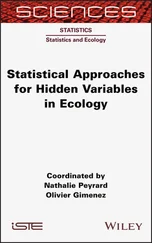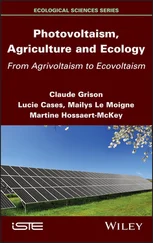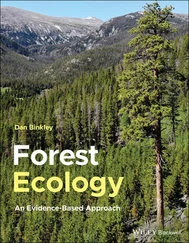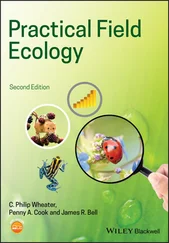APPLICATION 2.6 Farmers’ choice of cover crops in relation to temperature and soil water potential
Farmers have a wide choice of species that can be sown as cover crops during fallow periods to improve soil quality and reduce soil erosion and runoff. But which should they choose? Seed germination is a key stage in plant establishment, particularly when sowing occurs in summer, when temperatures are high and water availability low, and germination for 34 species of potential cover crops in four families was monitored in the laboratory at temperatures ranging from 4.5 to 43°C and at four water potentials ( Figure 2.21). Optimal temperatures for germination of seeds varied from 21.3 to 37.2°C; maximum temperatures at which the species could germinate varied from 27.7 to 43.0°C; and base water potentials, the lowest water potential at which a seed can germinate, varied from –0.1 to –2.6 MPa. (Note that at a potential of 0 MPa soil is in a state of saturation, while at –1.5 MPa soil is at its permanent wilting point (see Section 3.3.2).)

Figure 2.21 Niches of cover crops in terms of temperature and base water potential.(a) Response curves to temperature for selected species of cover crops in terms of percentage of seeds that germinate. (b) Niches in one dimension for various species of cover crop. Base water potential is the lowest water potential at which a seed can germinate. At one extreme, Vicia faba is very sensitive to water potential for germination while, at the other, Secale cereale can germinate at very low water potentials.
Source : From Tribouillois et al . (2016).
Most of the cover crops were adapted to summer sowing with a high mean optimal temperature for germination, but some, such as Vicia sativa ( Figure 2.21a), were more sensitive to high temperatures. Others, such as Secale cereale ( Figure 2.21b), were more resistant to water deficit and germinated even when water potential was very low. Tribouillois et al . (2016) classified the cover crops into functional groups that are of value to farmers when choosing species appropriate for their particular conditions. Thus, functional group 1, which includes Guizotia abyssinica and Setaria italica , has a minimal temperature of 10ºC, a maximal temperature of 41.2ºC and a base water potential of –0.9 KPa. Functional group 4, on the other hand, which includes Brassica rapa and Secale cereale , has a minimal temperature of 0.4ºC, a maximal temperature of 38.6ºC and a base water potential of –2.4 KPa.
The pH of soil in terrestrial environments or of water in aquatic ones is a condition that can exert a powerful influence on the distribution and abundance of organisms. The protoplasm of the root cells of most vascular plants is damaged as a direct result of toxic concentrations of H +or OH −ions in soils below pH 3 or above pH 9, respectively. Further, indirect effects occur because soil pH influences the availability of nutrients and/or the concentration of toxins.
Increased acidity (low pH) may act in three ways: (i) directly, by upsetting osmoregulation, enzyme activity or gaseous exchange across respiratory surfaces; (ii) indirectly, by increasing the concentration of toxic heavy metals at higher pHs, particularly aluminium (Al 3+) but also manganese (Mn 2+) and iron (Fe 3+), which are essential plant nutrients; and (iii) indirectly, by reducing the quality and range of food sources available to animals. Tolerance limits for pH vary amongst plant species, but only a minority are able to grow and reproduce at a pH below about 4.5.
In alkaline soils, iron (Fe 3+) and phosphate (  ), and certain trace elements such as manganese (Mn 2+), are fixed in relatively insoluble compounds, and plants may then suffer because there is too little rather than too much of them. For example, calcifuge plants (those characteristic of acid soils) commonly show symptoms of iron deficiency when they are transplanted to more alkaline soils. In general, however, soils and waters with a pH above 7 tend to be hospitable to many more species than those that are more acid. Chalk and limestone grasslands carry a much richer flora (and associated fauna) than acid grasslands and the situation is similar for animals inhabiting streams, ponds and lakes.
), and certain trace elements such as manganese (Mn 2+), are fixed in relatively insoluble compounds, and plants may then suffer because there is too little rather than too much of them. For example, calcifuge plants (those characteristic of acid soils) commonly show symptoms of iron deficiency when they are transplanted to more alkaline soils. In general, however, soils and waters with a pH above 7 tend to be hospitable to many more species than those that are more acid. Chalk and limestone grasslands carry a much richer flora (and associated fauna) than acid grasslands and the situation is similar for animals inhabiting streams, ponds and lakes.
Some Archaea can tolerate and even grow best in environments with a pH far outside the range tolerated by eukaryotes. Such environments are rare, but occur in volcanic lakes and geothermal springs where they are dominated by sulphur‐oxidising bacteria whose pH optima lie between 2 and 4 and which cannot grow at neutrality (Stolp, 1988). Thiobacillus ferroxidans occurs in the waste from industrial metal‐leaching processes and tolerates pH 1; T . thiooxidans cannot only tolerate but can grow at pH 0. Towards the other end of the pH range are the alkaline environments of soda lakes with pH values of 9–11, which are inhabited by cyanobacteria such as Anabaenopsis arnoldii and Spirulina platensis .
For terrestrial plants, the concentration of salts in the soil water offers osmotic resistance to water uptake. The most extreme saline conditions occur in arid zones where the predominant movement of soil water is towards the surface and crystalline salt accumulates. This occurs especially when crops have been grown in arid regions under irrigation; salt pans then develop and the land is lost to agriculture. The main effect of salinity is to create the same kind of osmoregulatory problems as drought and freezing and the problems are countered in much the same ways. For example, many of the higher plants that live in saline environments (halophytes) accumulate electrolytes in their vacuoles, but maintain a low concentration in the cytoplasm and organelles. Such plants maintain high osmotic pressures and so remain turgid, and are protected from the damaging action of the accumulated electrolytes by polyols and membrane protectants.
Freshwater environments present a set of specialised environmental conditions because water tends to move into organisms from the environment and this needs to be resisted. In marine habitats, the majority of organisms are isotonic to their environment so that there is no net flow of water, but there are many that are hypotonic so that water flows out from the organism to the environment, putting them in a similar position to terrestrial organisms. Thus, for many aquatic organisms the regulation of body fluid concentration is a vital and sometimes an energetically expensive process. The salinity of an aquatic environment can have an important influence on distribution and abundance, especially in places like estuaries where there is a particularly sharp gradient between truly marine and freshwater habitats.
The freshwater shrimps Palaemonetes pugio and P. vulgaris , for example, co‐occur in estuaries on the eastern coast of the USA at a wide range of salinities, but the former seems to be more tolerant of lower salinities than the latter, occupying some habitats from which the latter is absent. Figure 2.22shows the mechanism likely to be underlying this (Rowe, 2002). Over the low salinity range (though not at the effectively lethal lowest salinity) metabolic expenditure was significantly lower in P. pugio . P. vulgaris requires far more energy simply to maintain itself, putting it at a severe disadvantage in competition with P. pugio even when it is able to sustain such expenditure.
Читать дальше
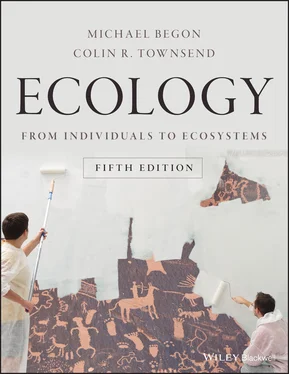

 ), and certain trace elements such as manganese (Mn 2+), are fixed in relatively insoluble compounds, and plants may then suffer because there is too little rather than too much of them. For example, calcifuge plants (those characteristic of acid soils) commonly show symptoms of iron deficiency when they are transplanted to more alkaline soils. In general, however, soils and waters with a pH above 7 tend to be hospitable to many more species than those that are more acid. Chalk and limestone grasslands carry a much richer flora (and associated fauna) than acid grasslands and the situation is similar for animals inhabiting streams, ponds and lakes.
), and certain trace elements such as manganese (Mn 2+), are fixed in relatively insoluble compounds, and plants may then suffer because there is too little rather than too much of them. For example, calcifuge plants (those characteristic of acid soils) commonly show symptoms of iron deficiency when they are transplanted to more alkaline soils. In general, however, soils and waters with a pH above 7 tend to be hospitable to many more species than those that are more acid. Chalk and limestone grasslands carry a much richer flora (and associated fauna) than acid grasslands and the situation is similar for animals inhabiting streams, ponds and lakes.


